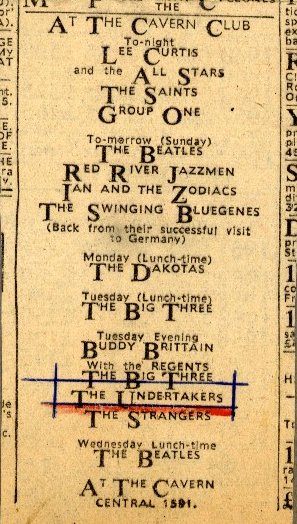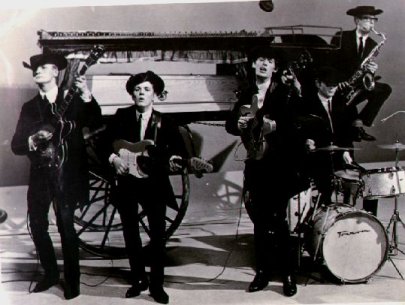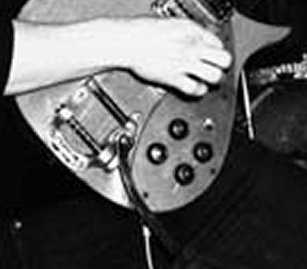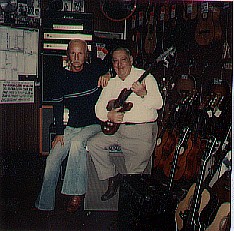| The
Undertakers, who counted the Beatles among their fans,
were one of more than 300 Merseyside rock and roll
combos but earned a special place in Scouse
hearts. Their sound is summed up nicely in their
allmusic.com entry: "With the saxophone, and the
thumping beat favored during this period, they sounded
very slightly like the Dave Clark Five, but Jones was a
more articulate player than that, and [Huston's] lead
guitar always made the group's sound pretty complex, and
Lomax was an incredibly charismatic soul singer, the
Merseyside rival to Eric Burdon and maybe better than
that. "
The group turned down a management
offer by Brian Epstein and enjoyed limited commercial
success. Their first two singles -- "(Do The)
Mashed Potatoes" b/w "Everybody Loves A Lover," and
"What About Us" b/w "Money" -- didn't chart well,
although the latter rivaled the Beatles' verison, but
their third single, "Just A Little Bit" b/w
"Stupidity," became a Top 20 hit in England during the
summer of 1964.
Dissatisfaction with their producer led
them to leave Pye and move to America, where they
hooked up with New York entrepreneur Bob Harvey and
his partner Bob Gallo, who were also handling Pete
Best. The group endured some rough sledding in
this period, but recorded one single, "I Fell In
Love," written by Bob Bateman, played whatever gigs
they could scrape up, and when not taking a back seat
to the Pete Best Combo, managed to record an album, Unearthed
(1965), which went unreleased for 30 years. 
When the money ran out, the Undertakers
went their separate ways, and Huston stayed in
America, carving out an impressive career as an
engineer and producer, working with such talents as
Led Zepplin, the Who, War, the Rascals, Todd Rundgren
, Van Morrison, Blood, Sweat & Tears, Mytch Ryder
& the Detroit Wheels, Ben E. King, the Drifters,
Patti La Belle & the Bluebelles, Solomon Burke,
Mary Wells, Wilson Pickett, John Hammond Jr., James
Brown, ? & the Mysterians, Robben Ford, Eric
Burden and many more. Among his accomplishments
are several dozen Gold and Platinum records (such as
the gold disc for "Groovin,'" pictured above, with
Rascal Gene Cornish), as well as a Grammy (for War's
"The World Is a Ghetto" ).
In addition to his many years in the
studio, live and remote recording all over the world,
and his work on numerous movie sound tracks, radio and
TV commercials, Huston launched a career as a designer
and acoustic consultant, with projects as varied as
recording studios and control rooms, radio stations,
dubbing and Foley/ADR stages, rehearsal studios, night
clubs, video stages, video editing suites, home
theaters, home studios, restaurants and churches.
Huston also lectures extensively to
architects and designers on acoustics in building
design and residential / industrial noise
control. One of his most satisfying experiences
is his lectures to graduate-student recording
engineers on recording techniques and record
production.
Huston saw Lennon for the last time in
1980, "at the Cherokee Recording Studios, a short while
before he was murdered, actually -- three or four
months. He'd come in to see Ringo. I was in
one studio, producing a session for Lonnie Jordan, the
lead singer of War, for a solo album, and Ringo was
working in another studio. So John comes walking
in with Yoko, and I'm coming out of my control room,
he's in the hallway, and just then Ringo comes out, and
John says, 'Hey Ringo, look who's here, it's Chris
Huston, the Undertaker!' Ringo says, 'I
know, he's been here all week,' So he goes back
into his room, and John and I start talking, you know,
just leaning in the hall for a bit, then we went off
into the lounge and talked for a while . . . with
friendships like that -- I mean, I didn't see him for 15
years, and our lives were so separate, but we had such a
background that you pick up where you left off.
There were never any airs . . ."
Having made his mark in the recording
studios of New York and Hollywood, and all points in
between, Huston now lives in Louisiana. It's
a long way from his beginnings in Merseyside, but he
carries many happy memories of that place and the people
he met there. He still has a creased Polaroid
photo of the Beatles -- with Pete Best and Stuart
Sutcliffe -- rehearsing at the Top Ten Club, taken by
the cigarette girl. "It was a very special time,"
says Huston. "You know, we didn't always realize
it. If I'd known it was going to be important, I
might have taken notes." |


 There, too, Huston got to meet many of
his idols, including Gene Vincent (left, with Huston
and Lomax at the Star Club), Ray Charles and Little
Richard. It was Germany, Huston remembers, that
changed the Beatles. "When they came back, it
was like they knew something we didn't know. It
was the strangest feeling . We went to see them,
and they had an energy, they had a fire about
them. I mean, we were all doing,
basically, the same numbers, but there was an
undeniable excitement and look about them."
There, too, Huston got to meet many of
his idols, including Gene Vincent (left, with Huston
and Lomax at the Star Club), Ray Charles and Little
Richard. It was Germany, Huston remembers, that
changed the Beatles. "When they came back, it
was like they knew something we didn't know. It
was the strangest feeling . We went to see them,
and they had an energy, they had a fire about
them. I mean, we were all doing,
basically, the same numbers, but there was an
undeniable excitement and look about them." 

